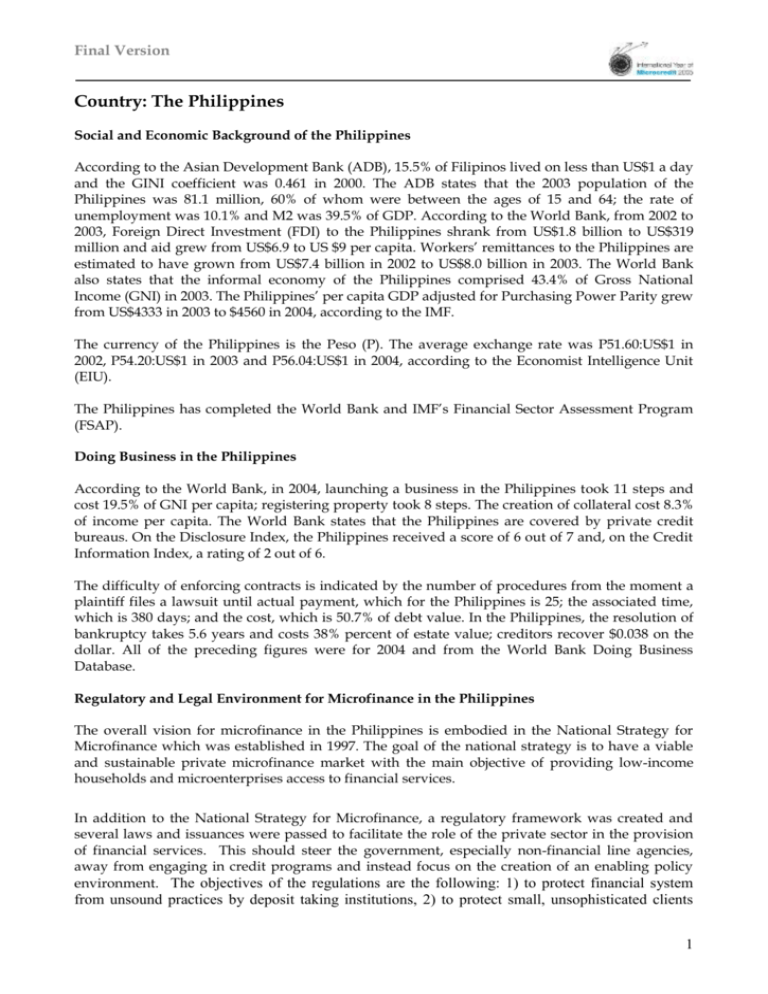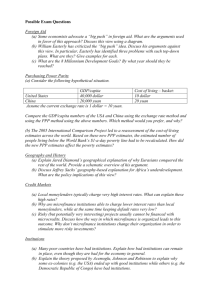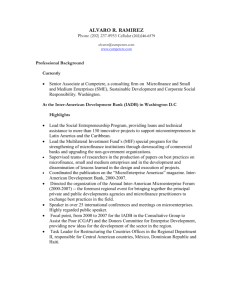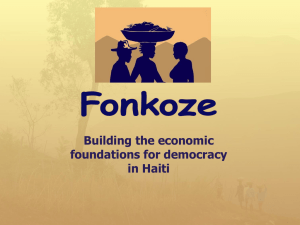Social and Economic Background of the Philippines
advertisement

Final Version Country: The Philippines Social and Economic Background of the Philippines According to the Asian Development Bank (ADB), 15.5% of Filipinos lived on less than US$1 a day and the GINI coefficient was 0.461 in 2000. The ADB states that the 2003 population of the Philippines was 81.1 million, 60% of whom were between the ages of 15 and 64; the rate of unemployment was 10.1% and M2 was 39.5% of GDP. According to the World Bank, from 2002 to 2003, Foreign Direct Investment (FDI) to the Philippines shrank from US$1.8 billion to US$319 million and aid grew from US$6.9 to US $9 per capita. Workers’ remittances to the Philippines are estimated to have grown from US$7.4 billion in 2002 to US$8.0 billion in 2003. The World Bank also states that the informal economy of the Philippines comprised 43.4% of Gross National Income (GNI) in 2003. The Philippines’ per capita GDP adjusted for Purchasing Power Parity grew from US$4333 in 2003 to $4560 in 2004, according to the IMF. The currency of the Philippines is the Peso (P). The average exchange rate was P51.60:US$1 in 2002, P54.20:US$1 in 2003 and P56.04:US$1 in 2004, according to the Economist Intelligence Unit (EIU). The Philippines has completed the World Bank and IMF’s Financial Sector Assessment Program (FSAP). Doing Business in the Philippines According to the World Bank, in 2004, launching a business in the Philippines took 11 steps and cost 19.5% of GNI per capita; registering property took 8 steps. The creation of collateral cost 8.3% of income per capita. The World Bank states that the Philippines are covered by private credit bureaus. On the Disclosure Index, the Philippines received a score of 6 out of 7 and, on the Credit Information Index, a rating of 2 out of 6. The difficulty of enforcing contracts is indicated by the number of procedures from the moment a plaintiff files a lawsuit until actual payment, which for the Philippines is 25; the associated time, which is 380 days; and the cost, which is 50.7% of debt value. In the Philippines, the resolution of bankruptcy takes 5.6 years and costs 38% percent of estate value; creditors recover $0.038 on the dollar. All of the preceding figures were for 2004 and from the World Bank Doing Business Database. Regulatory and Legal Environment for Microfinance in the Philippines The overall vision for microfinance in the Philippines is embodied in the National Strategy for Microfinance which was established in 1997. The goal of the national strategy is to have a viable and sustainable private microfinance market with the main objective of providing low-income households and microenterprises access to financial services. In addition to the National Strategy for Microfinance, a regulatory framework was created and several laws and issuances were passed to facilitate the role of the private sector in the provision of financial services. This should steer the government, especially non-financial line agencies, away from engaging in credit programs and instead focus on the creation of an enabling policy environment. The objectives of the regulations are the following: 1) to protect financial system from unsound practices by deposit taking institutions, 2) to protect small, unsophisticated clients 1 Final Version and 3) to promote the establishment of accurate, reliable and transparent set of financial information for all types of MFIs The regulation is intended for institutions taking deposits from the general public or from their members. These institutions (banks and cooperatives) are subject to prudential regulation and supervision. All banks, including those with microfinance operations, continue to be under the purview of the Central Bank of the Philippines (BSP) while cooperatives, including those with credit functions, continue to be under the purview of the Cooperative Development Authority. Microfinance NGOs are not allowed to take deposits and are required to submit transparent information on their operations. To further the objective of a transparent microfinance industry, a uniform set of performance standards for all types of retail microfinance institutions were established. The Philippines is among the first to have such a uniform set of standards. The standards will serve as microfinance industry benchmarks to allow performance comparison of all institutions engaged in the delivery of microfinance services. These benchmarks will also guide regulators in the assessment of financial institutions under their supervision. The standards focus on 4 key areas spelling out the acronym PESO (Portfolio Quality, Efficiency, Sustainability and Outreach). The principles set forth by the National Strategy have been the impetus for many positive developments in sustainable microfinance services. Increasing numbers of private microfinance institutions are providing much needed services while the government continues to direct credit programs and establish microfinance friendly policies and regulations. Practitioners are increasing their outreach while demonstrating a more serious commitment to upholding performance standards and best practices. Policy makers, supervisors and regulators have been proactively increasing their capacity to create a responsive and appropriate environment for microfinance. Banks’ Involvement in Microfinance in the Philippines The Philippine Central Bank (BSP) is the country’s monetary authority as well as the supervisor of the banking system. It has been mandated by the General Banking Law of 2000 to recognize microfinance as a legitimate banking activity and to set the rules and regulations for its practice within the banking sector. In the same year, the BSP declared microfinance as its flagship program for poverty alleviation. Since then, the BSP has issued 10 Circulars, undertaken training and capacity building as well as promotion and advocacy initiatives. In the first Circular, No. 272, the BSP defined microfinance as unsecured loans based on cash flow analysis that do not exceed US$2,667 to raise income levels and living standards. Circulars covered branching regulations, rediscounting facilities for microfinance as well as best practices for microfinance (i.e. measurement of Portfolio at risk). As a result, more banks are engaging in sustainable microfinance operations. There are currently 186 banks engaged in microfinance (4 microfinance oriented thrift banks, 4 microfinance oriented rural banks, and 178 rural and cooperative rural banks with some level of microfinance operations. In all, these banks have an outstanding portfolio of US$58.9 million. This is a significant increase from around 40 rural banks engaged in microfinance 4 years ago. The Microfinance Council of the Philippines, Inc (MCPI) reports that 23 MFIs are serving 637,360 active borrowers in 2004. 2 Final Version According to CGAP, there were 4,287 commercial banks, 1,193 thrift banks and 1,177 rural banks, 62 cooperative banks and 271 credit unions in 2004. Aside from the banking sector, cooperatives and NGOs are active in the provision of microfinance. For the Philippines, the Small Enterprise Education and Promotion (SEEP) Network listed two microfinance associations: the Alliance of Philippine Partners in Enterprise Development, Inc. (APPEND) and MCPI. APPEND was established in 1991 to alleviate poverty by facilitating microfinance. Its membership consists of 11 member institutions serving a combined total of 202,923 active clients. MCPI was established in 1997 to raise the performance standards of microfinance in the Philippines. It has 32 member institutions serving 508,000 clients. National Committee Activities in the Philippines In the Philippines, the National Committee is chaired by the Bangko Sentral ng Pilipinas (Central Bank of the Philippines) and is composed of key players in the field of microfinance from practitioners and policy makers to advocates. The Philippine celebration of the Year of Microcredit is committed to the objectives of building an appropriate policy environment, promoting sustainable microfinance institutions, and developing responsive microfinance services that ultimately benefit microfinance clients and improve the quality of their lives. The Committee launched the IYM with Vice President Noli de Castro as the Keynote Speaker and 350 people in attendance. Since then, it has organized a mini-trade show of products of microentrepreneurs, started circulation of the 20-Piso banknote with IYM logo overprint, and placed whole page advertisements in 6 major daily newspapers and several magazines. It has developed 5,000 posters and 300,000 flyers on microfinance, and distributed nearly 90% of posters and 80% of flyers nationwide through various relevant networks. The Committee has also launched a web site, www.microfinance.com.ph. Additionally, the National Committee has developed Microfinance Performance Standards and has seen the issuance of Presidential and Senate Proclamations on 2005 for the Philippine Year of Microfinance. Numerous events and activities focusing on the following have been organized: best practices for practitioners, policy dialogues with stakeholders, practitioners’ workshops and conferences, new microfinance technologies, and recognition of microfinance clients. The National Microfinance Summit was held in October 2005 with over 400 invitees, including the President Gloria Macapagal-Arroyo. The Philippine Declaration on Microfinance, which is the main action plan for microfinance in the Philippines, as well as the Memorandum of Agreement to adopt to the Uniform Set of Performance Standards for All Types of Microfinance Institutions were signed. At the event, a jingle for the International Year of Microcredit was played and an exhibit of products by microentrepreneurs took place. 3 Final Version Bibliography Agence France-Presse Philippines FDI seen rising 20-fold this year, May 11, 2005, May 28, 2005, <http://au.biz.yahoo.com/050511/33/4cfh.html> Asian Development Bank Key Indicators 2004: Poverty in Asia: Measurement, Estimates, and Prospects, Pub. Date: 2004, May 28, 2005, <http://adb.org/Documents/Books/Key_Indicators/2004/> Consultative Group to Assist the Poor Country Profile for Philippines, Last Updated : March 2003, May 28, 2005, <http://www.cgap.org/regsup/index.shtml> International Monetary Fund World Economic Outlook Database, April 2005, May 28, 2005, <http://www.imf.org/external/pubs/ft/weo/2005/01/data/index.htm> The Microfinance Council of the Philippines Update on the Performance of Council Members As of June 30, 2004, < http://www.microfinancecouncil.org/dload/Performance%20Monitoring%20Report%20%20June%202004.pdf > Small Enterprise and Education and Promotion Network Global Directory of Regional and Country-Level Microfinance Networks, October 24, 2004, May 28, 2005, <http://www.seepnetwork.org/files/2235_file_Asia_region_global_directory.pdf> World Bank Doing Business Database, September 2004, May 28, 2005, <http://rru.worldbank.org/DoingBusiness/> Global Development Finance 2004, 2004, May 28, 2005, <http://siteresources.worldbank.org/GDFINT2004/Home/20175281/gdf_appendix%20A .pdf> World Development Indicators database, Released on April 17, 2005, May 28, 2005, <http://www.worldbank.org/data/> 4






